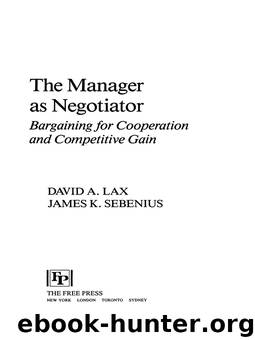The Manager as Negotiator Bargaining for Cooperation and Competitive Gain by DAVID A. LAX & JAMES K. SEBENIUS

Author:DAVID A. LAX & JAMES K. SEBENIUS
Language: eng
Format: epub
Publisher: THE FREE PRESS
Published: 1986-07-15T00:00:00+00:00
Problem Solving and Conflicting Interests
Before analyzing Hubbard’s specific situation, it is useful to summarize how the system was supposed to function:
Top management set corporate objectives and policies. Given these statements, Dowponto’s senior operating managers produced explicit statements of strategy (“Direction Papers”). Operating companies and similar units then produced “Summary Long-Range Plans,” followed by more detailed statements of strategies and tactics, “Operational Plans.” Next, individual managers identified the results they must achieve, the “Management by Results Program” to support the Operational Plans. The budgeting process was then to develop explicit statements of organizational goals and resource commitments for a one-year period.
The PRB system was the method used to facilitate this process. Its designers seemed to envision a clean, rational, problem-solving process: with all the participants wanting to maximize net present value, they would exchange information, rank the projects, agree on a total amount to be spent, and implement their decisions. Of course, this problem-solving model crashed into the reality of a hard bargaining process, where different interests and perceptions generated conflict and opportunistic interaction.
At this point in our example, the divisional strategy does not appear salient. The PRB process itself is in tatters, conflict among the participants has been exacerbated, and whatever shared interests might unify the group seem all but invisible.
Hubbard might dredge up a series of negotiation nuggets. (Maybe now is a good time for a power lunch. Adopt a win-win orientation. Be creative. The keys are power, time, and information. It’s all psychology. Exchange your leisure suit for a powerful gray one with pinstripes.) What he really needs, however, is a general approach and a way to choose specific next steps. Should he open the afternoon meeting with an impassioned brief for cooperation? Should he be stern, threatening, or even suggest that the participants lock themselves up until they can reach an agreement? Should he bring a higher up, such as Tavner, into the process? Should he do the budget himself this year and merely put it out in a PRB format? Or, should he take another tack?
We will approach this problem by self-consciously applying our framework to get an idea of the general structure of the situation. This will enable us to evaluate more particularly what has happened and to suggest specific next steps in line with a broader strategy.
Download
This site does not store any files on its server. We only index and link to content provided by other sites. Please contact the content providers to delete copyright contents if any and email us, we'll remove relevant links or contents immediately.
Hit Refresh by Satya Nadella(8866)
The Compound Effect by Darren Hardy(8524)
Change Your Questions, Change Your Life by Marilee Adams(7385)
Nudge - Improving Decisions about Health, Wealth, and Happiness by Thaler Sunstein(7261)
The Black Swan by Nassim Nicholas Taleb(6782)
Deep Work by Cal Newport(6587)
Daring Greatly by Brene Brown(6230)
Rich Dad Poor Dad by Robert T. Kiyosaki(6191)
Principles: Life and Work by Ray Dalio(5984)
Man-made Catastrophes and Risk Information Concealment by Dmitry Chernov & Didier Sornette(5669)
Playing to Win_ How Strategy Really Works by A.G. Lafley & Roger L. Martin(5528)
Digital Minimalism by Cal Newport;(5397)
Big Magic: Creative Living Beyond Fear by Elizabeth Gilbert(5361)
The Myth of the Strong Leader by Archie Brown(5244)
The Slight Edge by Jeff Olson(5203)
Discipline Equals Freedom by Jocko Willink(5160)
The Motivation Myth by Jeff Haden(5010)
Stone's Rules by Roger Stone(4867)
The Laws of Human Nature by Robert Greene(4790)
